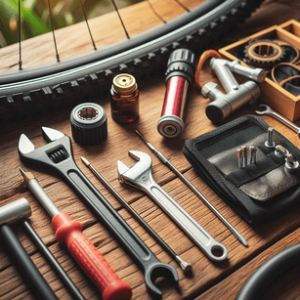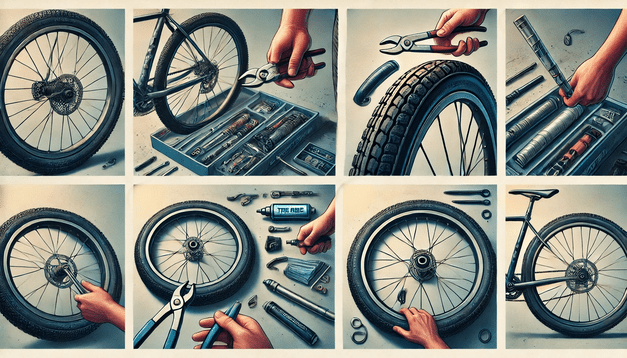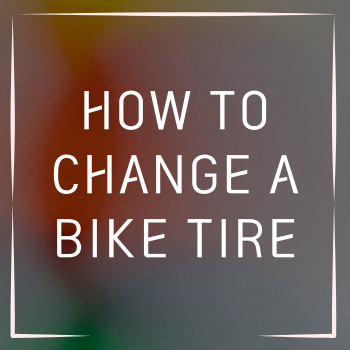Knowing how to change a bike tire is an essential skill for every cyclist. Whether you’re a casual rider or a dedicated enthusiast, being able to handle a flat tire or replace worn-out tires can save you time, money, and frustration. In this comprehensive guide, we’ll walk you through the process of changing a bike tire step-by-step, covering everything from understanding bike tires to maintaining them for optimal performance.
Understanding Bike Tires
Before we dive into the process of changing a bike tire, it’s crucial to understand the basics of bike tires and their components.
What are the components of a bike tire?
A bicycle tire consists of several key components:
- Tire: The outer rubber part that contacts the road
- Tube: The inner inflatable part (in most cases)
- Rim: The metal hoop of the wheel that the tire sits on
- Valve: The part of the tube that allows air to be added or released
- Rim tape: A protective layer between the tube and rim
Understanding these components is essential when you need to change a bike tire or perform any tire-related maintenance.
How often should bike tires be replaced?
The frequency of tire replacement depends on several factors:
- Usage: More frequent riding leads to faster wear
- Terrain: Rough surfaces wear tires more quickly
- Tire quality: Higher-quality tires generally last longer
- Maintenance: Proper care extends tire life
As a general rule, road bike tires typically last 1,000-3,000 miles, while mountain bike tires may need replacement after 1,000-7,000 miles. However, it’s essential to regularly inspect your tires for signs of wear, such as:
- Flat spots
- Exposed threads
- Frequent punctures
- Cracks in the rubber
If you notice any of these signs, it’s time to change your bike tire.
Tools Needed to Change a Bike Tire
Before you start the process of changing a bike tire, gather the following tools:
- Tire levers (2-3)
- Spare tube or tire
- Bike pump or CO2 inflator
- Wrench (if your bike doesn’t have quick-release wheels)
- Patch kit (optional, for repairing tubes)
Having these tools on hand will make the process of changing a bike tire much smoother and more efficient.

Dealing with a Flat Tire
What should you do if you get a flat tire while riding?
If you experience a flat tire while on a ride, follow these steps:
- Safely stop and move off the road
- Assess the situation: Can you repair it on the spot, or do you need to call for help?
- If you have the necessary tools, proceed to change the tire
- If you can’t change the tire, walk your bike to the nearest bike shop or call for assistance
How to use tire levers to remove the tire?
Tire levers are essential tools for removing the tire from the rim. Here’s how to use them:
- Deflate the tire completely
- Insert the flat end of the tire lever under the tire bead
- Lever the tire over the rim edge
- Secure the lever to a spoke
- Insert a second lever about 4-6 inches away from the first
- Work your way around the rim, using the levers to lift the tire off
How to inspect the tire for damage?
After removing the tire, carefully examine both the tire and tube:
- Check the tire for cuts, embedded objects, or excessive wear
- Inspect the tube for punctures or tears
- Run your fingers along the inside of the tire to feel for any sharp objects that might have caused the flat
- Check the rim tape for proper positioning and any signs of wear
Replacing the Bike Tire

How to remove the old tire from the rim?
To remove the tire from the rim:
- Fully deflate the tire
- Use tire levers to unseat one side of the tire bead from the rim
- Work your way around the entire wheel
- Once one side is free, the other side should come off easily
How to properly align the new tire with the rim?
When installing a new tire:
- Locate the directional arrows on the tire sidewall (if present)
- Align one side of the tire onto the rim
- Start at the valve hole and work your way around
- Use your thumbs to push the tire bead into the rim
- For the second side, start at the valve and work outwards in both directions
- Use tire levers carefully if needed for the last section
How to inflate the tire to the correct pressure?
Proper inflation is crucial for optimal performance and safety:
- Check the recommended pressure range on the tire sidewall
- Use a pump with a pressure gauge
- Inflate to the lower end of the range for a softer ride or the higher end for less rolling resistance
- Check pressure regularly, as tires naturally lose air over time
Tips for Maintaining Bike Tires
How to check tire pressure regularly?
Regular pressure checks are essential:
- Use a quality pressure gauge
- Check pressure at least once a week
- Adjust pressure based on riding conditions and personal preference
- Remember that temperature changes can affect tire pressure
How to ensure the tire is properly seated on the rim?
A properly seated tire is crucial for safety:
- Inflate the tire to about half the recommended pressure
- Check the bead line (the molded line just above the rim) for consistency all the way around
- If uneven, deflate and reseat the tire
- Once even, fully inflate to the recommended pressure
When should you consider replacing the tire instead of just patching it?
Consider replacing your tire if:
- The tire has multiple patches
- There are large cuts or tears in the tire
- The tread is worn down significantly
- The sidewalls show cracks or excessive wear
- You experience frequent flats despite patching
Regular maintenance and timely replacement of your bike tires will ensure a safer, more enjoyable riding experience.
Conclusion
Learning how to change a bike tire is an invaluable skill for any cyclist. By following this guide and practicing the process, you’ll be well-prepared to handle flat tires and perform routine maintenance on your bike. Remember to keep your tires properly inflated, regularly inspect them for wear, and always carry the necessary tools for emergency repairs. With these skills and habits, you’ll be able to enjoy your rides with greater confidence and peace of mind.
